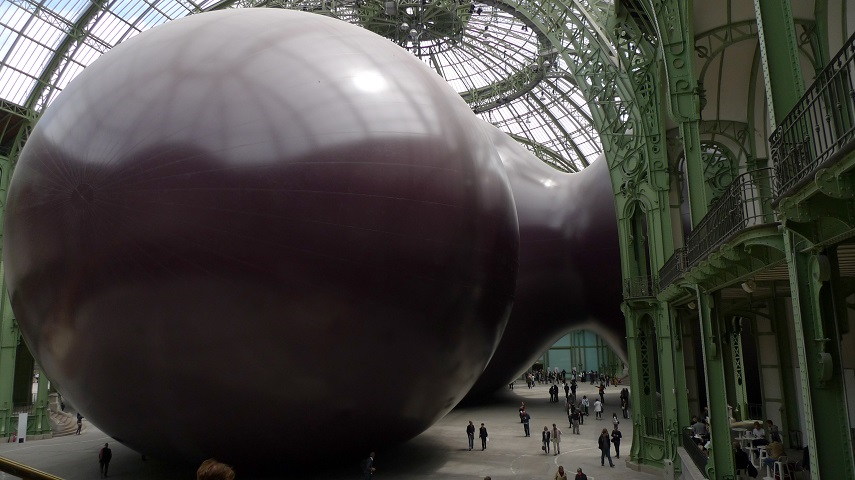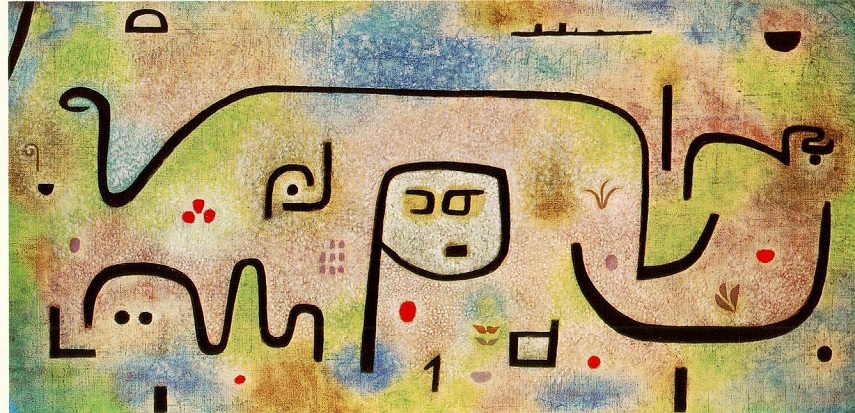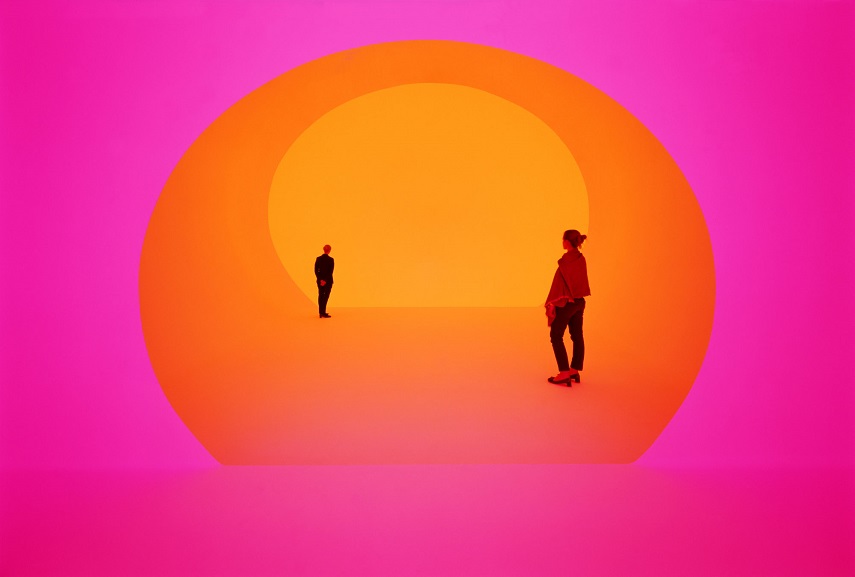ââ‹threedimensional Works Art of Define and Occupy ã¢ââ€as Opposed to Illusoryã¢ââ€space
What is space? With this question can outset nigh whatever consideration of infinite in fine art. The definition of space gives u.s. trivial to agree onto apropos its characteristics besides that information technology exists only in relation to something, or someone. Encyclopedia Britannica defines space as "a boundless, three-dimensional extent in which objects and events occur and have relative position and management." [1] Position and even direction in art may have some currency in previous ages when art had its strictly defined purpose of representing the living or metaphysical world. Yet, fifty-fifty the metaphysical one relied heavily on our perception and imagination, and was made similar to the palpable reality. As artistic styles developed and avant-garde movements took over the art world by storm, space in art started to dissolve and forms that filled artworks were defined along a much simpler differentiation between positive and negative infinite. While talking well-nigh the definition of infinite in art, positive stands in this equation for the place occupied by course, while negative is what remains between and effectually the form'southward shapes. Such distinction is non something typical for this period in art history, simply is nonetheless taken to the fore, as other spatial differentiation achieved through perspective and depth were not applicable anymore.
Examining space in fine art must always take into account the complex social and cultural standings of a given time. Space is not something that was always represented with the pure artistic ideas backside information technology. Sometimes, the needs coming from the outside of the artistic earth influenced the way space was understood and depicted. In what follows, nosotros track some of the changes in its depiction, and give a few examples to stimulate farther thinking virtually spatial relations in art.

Types and Examples of Space in Art
Negative, positive, implied or real, all these attributes apply to space and its representation and use in arts. Negative or positive space, as mentioned above, is non something that is only applied and used in certain artworks just is a more general differentiation that is applicable to painting, sculpture, installation and other art forms. Maybe the most notable example of the employ of negative and positive space is Henry Moore 'southward sculpture that relies on the interplay betwixt negative and positive areas; between full forms and their absence. In installations real space is of the utmost importance as information technology oftentimes becomes actively engaged in the work, as in the case from the 2015 Japan Pavilion at the Venice Biennale. Chiharu Shiota's The Key in the Mitt installation was meticulously crafted in the pavilion, and its spatial structures influenced the last outlook of the whole piece. The dream-like effect the artist achieved through the use of red yarn, keys and boats, engulfs the gallery in the melancholic atmosphere of loss, but also of opportunity and hope.[2] Implied infinite in paintings is sometimes depicted following the rules of depth and perspective, and sometimes we tin can refer to information technology simply in relation to abstract shapes and their compositional arrangement on the sail. Paul Klee 's abstraction, for case, does non possess the spatial orderings equally figurative art, but all the same his whimsical shapes and objects are spatially bundled as to create an engaging and dynamic effect.
Click here to run into available works by Henry Moore on our market!

Metaphysical and Palpable Spaces - From Bernini to Rothko and Troika
Practise yous remember Bernini's Ecstasy of St. Teresa? A religious ecstasy visualized in the figure of an affections, the arrow that is nearly to pierce the nun'southward heart, and the golden shower of God's dear. All nicely situated in an elevated aedicule. Space in this Baroque masterpiece is not merely relative to the surroundings where the sculptural figures are situated, only also transcends the immediacy of the palpable area to include the metaphysical one, materialized in physical and recognizable forms. Two spaces and realities merge, but relations that guide our sense of space are preserved here. Even the aedicule is engaged in the last result of the piece where a small window in the upper function of the architectural element allows light to fall down onto Bernini'due south composition.
Engaging space to create a metaphysical experience is not unknown to gimmicky artists as well. Examples abound form painting, sculpture and installation fine art. In painting, 1 of the best-known examples is Rothko 's piece of work. On his canvases space is flatten-out in splashes of color that should provoke contemplation and induce metaphysical peace. Similarly interested in metaphysical furnishings of space in art is the London-based artist trio Troika - Eva Rucki, Conny Freyer and Sebastien Noel. In 2012 they made a site-specific architectural installation named Arcades, comprised of light pillars which rays refracted by a fresnel lens created the illusion of gothic arches. As the artists stated: "creating a spatial suspension of atheism, Arcades encourages an assay of our human relationship with the metaphysical in a world increasingly governed by applied, rational and scientific principles." [3]

Space in Cultural Clashes
An of import aspect that should not be neglected when space in art or other artistic elements are examined, is its office in the so-called cultural clashes, particularly during the imperial say-so of the Western Europe over unlike world regions and cultures. The style space was represented in arts served as one of the aspects of how artworks were valued, and this was purposefully used in problematic hierarchical orderings. It was one of the markers that differentiated high art from the so-called crafts of "tribal cultures". Non acceptant of the unlike modes of representing reality, Imperialists arrogantly assumed that if infinite is not nicely rendered in perspective as in their fine art since the Renaissance, if figures or perspective are non presented in a realistic way - this testifies to a somewhat lower cultural level of the population that created them. Drawing from their own past of the middle ages and its arts where space was divers forth the dissimilar lines excluding those of perspective and depth, they linked other forms with like neglect of spatial orderings as astern and intelligible to a rational listen.

Disturbing Our Notions of Space - Modern and Contemporary Fine art
In the video sample beneath, fromKubrick'due south famous moving-picture show 2001: Space Odyssey, the space is problematized on several levels, starting from the viewer's perspective, to the perspective of bodily performers in the picture show. The stability of their position is masterfully put out of balance and gravitational order, but they seem to keep their work unencumbered by this. On the other mitt, the viewers are shifted out of their comfort zone and are unable to grasp the spatial relations and orderings presented to them. The chamber of the spaceship in which the action takes place in not defined in usual terms that assist us make sense of the identify we are in, or of the place we are observing. What is up, and what is down? Left and correct too seem to lose pregnant. We are presented with a visual slice which expressiveness relies on the loss of spatial orientation in its observers.
Kubrick'due south Play with Space - 2001: A Space Odyssey
Fine art That Consumes Space - James Turrell and Anish Kapoor
Other examples of space in art that poke at our sense similarly to Kubrick's cult film come from the world of installation and calorie-free art. James Turrell , a well-known and established writer focuses on the color and light effects that in coaction with the surface area in which they are produced create a transcendental effect. His take on space may be closely linked with those of abstract artists who shunned the importance of spatial differentiations for the effects pure color may produce in the observer. Turrell uses places as canvases on which he reproduces colors of such intensity that visually dissolve concrete boundaries. The achieved event tin can be compared with the physical inbound into an abstract painting. While Turrell consumes space with colour, Anish Kapoor'south Leviathan devours it with its gigantic calibration. Situated in the Grand Palais in 2011, this inflatable awe-inspiring slice stirs thinking on relations between contemporary fine art and artistic traditions, but too on our bodies, origins and experiences. For Kapoor Leviathan is "a single object, a single form, a single color" that creates a infinite within a space, and which hopefully manages"through strictly physical ways, to offer a completely new emotional and philosophical experience." [4]
Interested in the art of Anish Kapoor? Click here to see more works!

Space in Art through the Trajectories of Perception
Our short travel through art history shows how space was differently used in artistic practices and how important it was and still is to any creative process. Rarely considered simply a passive element of an artwork, space is more oftentimes an active participant in its evolution, as seen from Shiota's and Turrell'southward works. Sometimes social and artistic conventions influence how it is used and represented, just more commonly creatives employ information technology in order to probe some sedimented artistic and cultural mores, such is the case with Kapoor's and Kubrick's art. Perception plays an of import role in deciding on how space will exist utilized. From the Middle Ages when religious themes were done in a relatively flat spatial orderings, as the importance of the motifs surpassed the need for visual veracity, to a Renaissance awakening to the importance of humanity in the general schemes of the universe, in which centrality of our reality became the guiding principle in art, to modern and contemporary rejections of hierarchical potency of any worldview, representations of space followed this trajectory in art and remained an of import factor in its aesthetics.
Featured images: Chiharu Shiota - The Primal in the Hand, 2015. Image via dreamofitaly.com; Sesshū Tōyō - Haboku-Sansui, 1495; Mark Rothko - No.61, Image via Widewalls archive. All images used for illustrative purposes only.
References:
- Anonymous, Space: Physics and Metaphysics , britannica.com [December 9, 2016]
- Anonymous, (2015), Chiharu Shiota: "The Cardinal in the Mitt" , 2015.veneziabiennale-japanpavilion.jp [December 9, 2016]
- Ker A., (2016), A Metaphysical Exploration Of Light And Space , ignant.com [December 9, 2016]
- Anonymous, Monumenta 2011 , marthagarzon.com [December nine, 2016]
Source: https://www.widewalls.ch/magazine/space-in-art


0 Response to "ââ‹threedimensional Works Art of Define and Occupy ã¢ââ€as Opposed to Illusoryã¢ââ€space"
Post a Comment